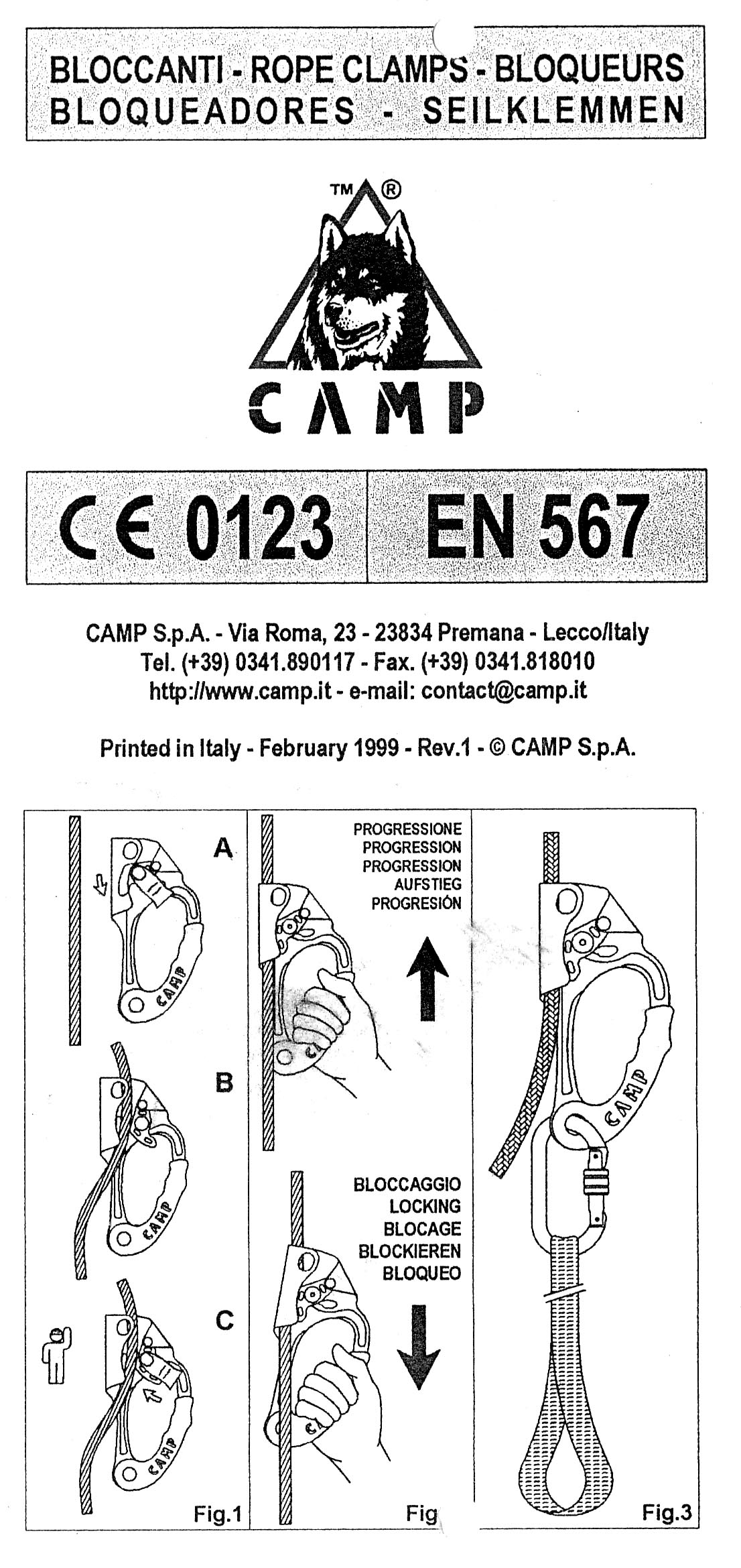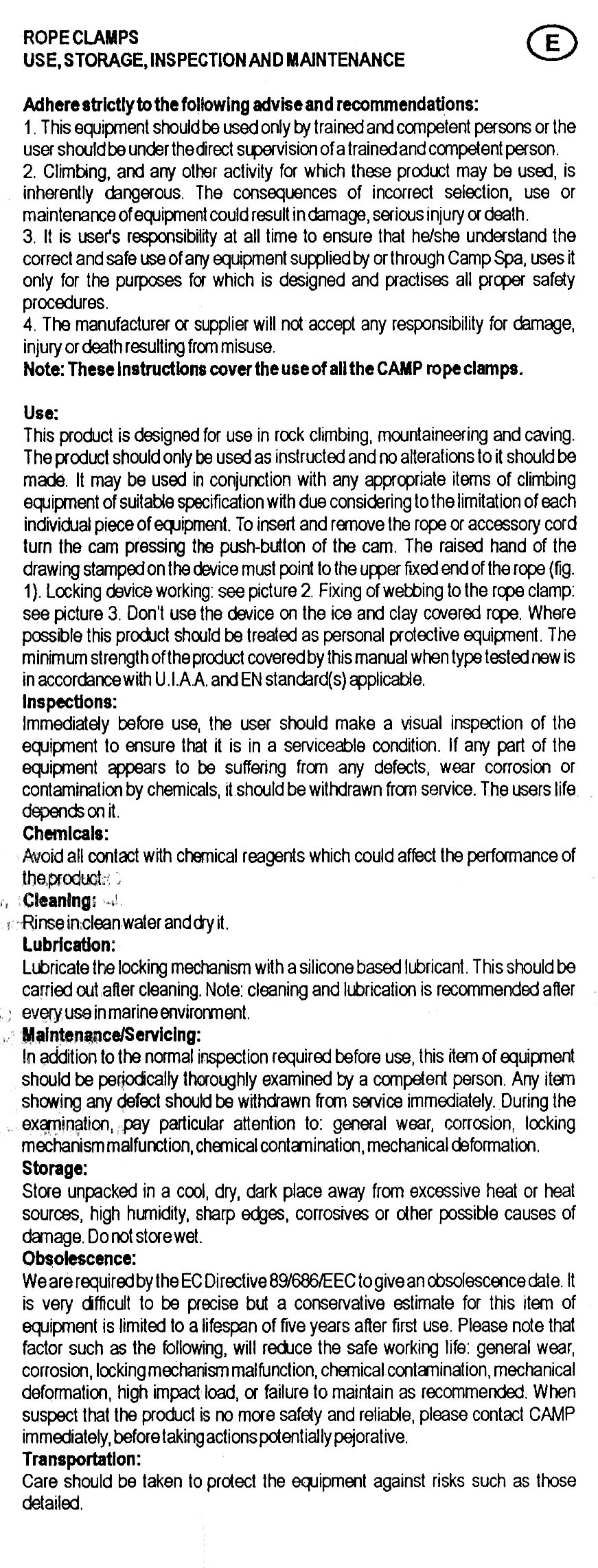Overview
History
Blacksmith Nicola Codega founded C.A.M.P. in 1889 to produce wrought-iron goods. The company first entered the climbing equipment business in 1920 when Nicola's son Antonio started making ice axes for the Italian Army Alpine Corps. The firm continued to grow and was handed down through the family.
From about 1950 through 1976, C.A.M.P. used a diamond-shaped logo bearing "D CN & FD CAMP" for "Ditta Codega Nicola & Figli De Codega Antonio Metilde Premana."
In 1968, C.A.M.P. entrusted Robert Charles Maillot and his firm Interalp to distribute C.A.M.P. products outside Italy. These products bore both C.A.M.P. and INTERALP logos. Their relationship continued until 1980.
C.A.M.P. changed its name to "Construzione Articoli Montagna Premana" in 1972.
In 1972 C.A.M.P. started using a new logo with "CAMP" inside a rounded rectangle above a mountain. The transition was completed around 1976.
C.A.M.P. introduced a new wolfs-head logo in 1992.
C.A.M.P. acquired Cassin in 1997.
In 2003 C.A.M.P. again changed the company name, this time to "Concezione Articoli Montagna Premana" and changed their logo to CAMP in italics.
C.A.M.P. introduced another new logo in 2022 and returned to the name "Construzione Articoli Montagna Premana."

Many C.A.M.P. products from recent decades have a product traceability code that indicates when they were made. Denis Pivot sent me the following "secret decoder ring" for interpreting these codes:
- Until and including 1995: The code is three or four digits. The first one or two indicate the batch number and the remaining two indicate the year.
- For example, "295" means second batch made in 1995.
- From 1996 through 2005, The code is a numeral indicating the batch nmuber and a letter in the Italian alphabet indicating the year, with A in 1996 through I in 2004 and L in 2005 (J and K do not exist) .
- For example, "1D" means the first batch made in 1999.
- From 2006 unttil 2016: The code is three digits. the first indicates the batch number and the remaining two indicate the year.
- For example, "216" means second batch made in 2016.
- From 2017 onward: The code is two two-digit numbers, where the first indicates the month and the second pair indicates the year.
- For example, "05 17" means it was made in May 2017.
Some products may not have received a product traceability code.
[ Top
| Solo, Ver. B
| Solo 2
| Return to E.C. Ascenders
]
Solo, Version A
(#150)
Technical Details
I acquired this pair of ascenders from K&R Adventure Gear
in February 2001. It was from the third batch made in 1999.
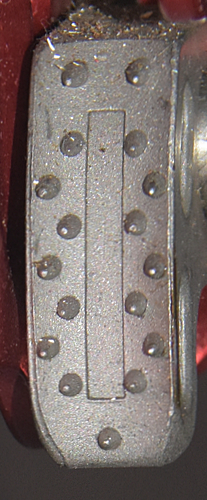 The shell is an irregular shaped anodized stamping made from
3.5 mm. aluminum alloy sheet metal. The ascender is right-handed,
as are similar ascenders made by others. The stamping has a reinforcing
rib below the cam. A rope channel is formed in the left side
and a smaller cam channel lies to the right. A hole drilled through
both sides of the cam channel accepts a 4 mm. pin which enters
from the rear and is expanded in front. The cam, cam spring and
a spacing washer are mounted on this pin. A 15.8 mm. sling
attachment hole is punched below the cam. A 14.6 by 18.3 mm.
oval hole through both sides of the rope channel provide an attachment
point just above the cam. An arc-shaped slot is punched below
and concentric with the cam pivot. This slot is enlarged at both
ends and narrow in the center. The cam safety rides in this slot.
The shell is an irregular shaped anodized stamping made from
3.5 mm. aluminum alloy sheet metal. The ascender is right-handed,
as are similar ascenders made by others. The stamping has a reinforcing
rib below the cam. A rope channel is formed in the left side
and a smaller cam channel lies to the right. A hole drilled through
both sides of the cam channel accepts a 4 mm. pin which enters
from the rear and is expanded in front. The cam, cam spring and
a spacing washer are mounted on this pin. A 15.8 mm. sling
attachment hole is punched below the cam. A 14.6 by 18.3 mm.
oval hole through both sides of the rope channel provide an attachment
point just above the cam. An arc-shaped slot is punched below
and concentric with the cam pivot. This slot is enlarged at both
ends and narrow in the center. The cam safety rides in this slot.
The cam is a skeletonized steel casting. The cam has seventeen
small conical teeth, all of which have their axes approximately
parallel to each other. The central teeth have their axes in line
with the cam pivot. The tooth pattern is (2)(1D1)^7(1) where D
is a shallow depression that does not penetrate the cam face. Unlike
some other ascenders, the inner cam face radius appears to be
constant. A spring-loaded manual safety passes through the cam
and the arc-shaped slot in the shell. The head of the safety forms
a 15 mm. diameter round-headed button. The safety shaft is
6 mm. in diameter, then increases to 8.5 mm. where it
passes through the shell, and finally to 11 mm. Normally
a spring pushes the safety toward the front of the ascender, and
the enlarged 8.5 mm. portion fits into one of the large areas
of the slot. Depending on which end of the slot it is in, this
either keeps the cam from opening enough to release the main rope
or keeps the cam from closing. Pushing the head of the safety
aligns the 6 mm. shaft with the shell, allowing the cam to
move through it’s full range of motion.
The front of each ascender has the C.A.M.P. Logo, the "Sieg Heil" icon, "EN
567," "CE0123," "ROPE," "min ø
8" and "max ø 13" printed onto the rope
channel . "Italy" and "3D" are printed on
the cam channel.
This is another well made ascender. All sharp edges have been
removed. The cam teeth are very well done. The attachment points
are simply holes in the shell, and though beveled, I would prefer
not to tie directly into them. Considering the proximity of the
attachment points to the main rope, I would recommend using a
small maillon for most attachments in order to reduce the risk
of sling abrasion. The upper rope attachment hole is located very
close to the main rope. A carabiner through the upper attachment
hole will probably drag on the main line. Note that such a carabiner
will prevent putting the ascender on or off rope, so one’s climbing
system must be designed accordingly.
I found the safety took a few minutes to get used to, but after
minimal practice I decided that this is one of the easier safeties
to operate for ascenders of this type. Single-handed operation
of this ascender is fairly easy with the either hand. Closing
an locked open ascender is accomplished with a simple push on
the button. The cam is very well made.
C.A.M.P. makes a handled Version of the Solo, the C.A.M.P.
Pilot.

[ Top
| Solo, Ver. A
| Solo 2
| Return to E.C. Ascenders
]
Solo, Version B
(#2125)
Technical Details
I acquired this ascender in 2017 as part of Bob Thrun’s collection. It was from the first batch made in 2005.
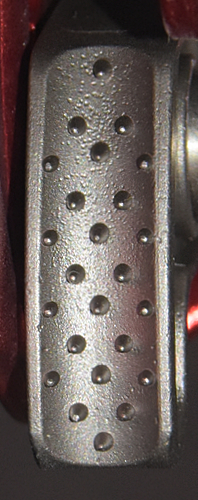 Version B is 116 mm. tall, 75 mm. wide, 31 mm. thick, and weighs 157 g. The shell is an irregular shaped anodized stamping made from
3.5 mm. aluminum alloy sheet metal. The ascender is right-handed,
as are similar ascenders made by others. The stamping has a reinforcing
rib below the cam. A rope channel is formed in the left side
and a smaller cam channel lies to the right. The rope channel is 13 mm. wide. A hole drilled through
both sides of the cam channel accepts a 4 mm. pin which enters
from the rear and is expanded in front. The cam, cam spring and
a spacing washer are mounted on this pin. A 15.8 mm. sling
attachment hole is punched below the cam. A 14.6 by 18.3 mm.
oval hole through both sides of the rope channel provide an attachment
point just above the cam. An arc-shaped slot is punched below
and concentric with the cam pivot. This slot is enlarged at both
ends and narrow in the center. The cam safety rides in this slot.
Version B is 116 mm. tall, 75 mm. wide, 31 mm. thick, and weighs 157 g. The shell is an irregular shaped anodized stamping made from
3.5 mm. aluminum alloy sheet metal. The ascender is right-handed,
as are similar ascenders made by others. The stamping has a reinforcing
rib below the cam. A rope channel is formed in the left side
and a smaller cam channel lies to the right. The rope channel is 13 mm. wide. A hole drilled through
both sides of the cam channel accepts a 4 mm. pin which enters
from the rear and is expanded in front. The cam, cam spring and
a spacing washer are mounted on this pin. A 15.8 mm. sling
attachment hole is punched below the cam. A 14.6 by 18.3 mm.
oval hole through both sides of the rope channel provide an attachment
point just above the cam. An arc-shaped slot is punched below
and concentric with the cam pivot. This slot is enlarged at both
ends and narrow in the center. The cam safety rides in this slot.
The cam is a skeletonized steel casting. The cam has seventeen
small conical teeth, all of which have their axes approximately
parallel to each other. The central teeth have their axes in line
with the cam pivot. The cam radius increases from 33 to 50 mm. over an angle of 44°, giving a 28° cam angle. The tooth pattern is (1)(2.3)^4(2.1). Unlike
some other ascenders, the inner cam face radius appears to be
constant. A spring-loaded manual safety passes through the cam
and the arc-shaped slot in the shell. The head of the safety forms
a 15 mm. diameter round-headed button. The safety shaft is
6 mm. in diameter, then increases to 8.5 mm. where it
passes through the shell, and finally to 11 mm. Normally
a spring pushes the safety toward the front of the ascender, and
the enlarged 8.5 mm. portion fits into one of the large areas
of the slot. Depending on which end of the slot it is in, this
either keeps the cam from opening enough to release the main rope
or keeps the cam from closing. Pushing the head of the safety
aligns the 6 mm. shaft with the shell, allowing the cam to
move through it’s full range of motion.
The front of each ascender is stamped with "CAMP," the "Sieg Heil" icon, "ROPE," "min Ø8" and "max Ø13." The inside is stamped with "CE," "0123," "EN 567," and the Reading-Is-Dangerous icon. The rear is stamped with "Italy" and "1-L."
This is another well made ascender. All sharp edges have been
removed. The cam teeth are very well done. The attachment points
are rounded holes in the shell, but I would prefer
not to tie directly into them. Considering the proximity of the
attachment points to the main rope, I would recommend using a
small maillon for most attachments in order to reduce the risk
of sling abrasion. The upper rope attachment hole is located very
close to the main rope. A carabiner through the upper attachment
hole will probably drag on the main line. Note that such a carabiner
will prevent putting the ascender on or off rope, so one’s climbing
system must be designed accordingly.
I found the safety took a few minutes to get used to, but after
minimal practice I decided that this is one of the easier safeties
to operate for ascenders of this type. Single-handed operation
of this ascender is fairly easy with the either hand. Closing
an locked open ascender is accomplished with a simple push on
the button. The cam is very well made.

[ Top
| Solo, Ver. A
| Solo, Ver. B
| Return to E.C. Ascenders
]
Solo 2
(#1988)
Technical Details
I acquired my C.A.M.P. Solo 2 from Expé-Spelemat in 2014. It was made in February of that year.
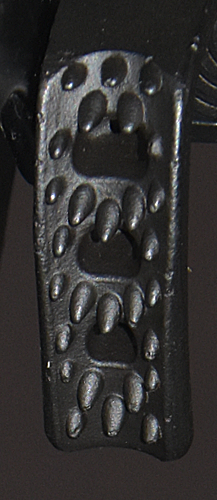 My C.A.M.P. Solo 2 is 93 mm. tall, 55 mm. wide, 24 mm. thick, and weighs 92 g. The shell is an irregular shaped anodized stamping made from
3.5 mm. aluminum alloy sheet metal. The ascender is right-handed,
as are similar ascenders made by others. The stamping has a reinforcing
dimple below the cam. A rope channel formed in the left side is 14 mm. wide. A hole drilled through
the shell supports a 6 mm. pin which enters
from the front and is riveted over a bushing in the rear. The cam, cam spring and
a spacing washer are mounted on this pin. A small pin riveted below the cam axle acts as a cam stop. A 14 mm. sling
attachment hole is punched below the cam and a second 14 mm. punched hole provides an attachment
point just above the cam. The shell surrounding the lower hole is offset to the rear in the fourth quadrant.
My C.A.M.P. Solo 2 is 93 mm. tall, 55 mm. wide, 24 mm. thick, and weighs 92 g. The shell is an irregular shaped anodized stamping made from
3.5 mm. aluminum alloy sheet metal. The ascender is right-handed,
as are similar ascenders made by others. The stamping has a reinforcing
dimple below the cam. A rope channel formed in the left side is 14 mm. wide. A hole drilled through
the shell supports a 6 mm. pin which enters
from the front and is riveted over a bushing in the rear. The cam, cam spring and
a spacing washer are mounted on this pin. A small pin riveted below the cam axle acts as a cam stop. A 14 mm. sling
attachment hole is punched below the cam and a second 14 mm. punched hole provides an attachment
point just above the cam. The shell surrounding the lower hole is offset to the rear in the fourth quadrant.
The cam is a skeletonized steel casting. The cam radius increases from 37 to 55 mm. over an angle of 42°, giving a 28° cam angle. The tooth pattern is (3.2)(1H1.2)^2(1H1.2.3). A spring-loaded manual safety mounts on the bottom inside of the cam. A small cord and tab resembling a zipper pull is tied to a hole in the safety.
The front of the ascender is printed with the C.A.M.P. Safety logo, "SOLO 2," and "Ref.2257." The inside of the shell has a printed book-with-an-"i" icon. The rear is printed with "Made in Italy," "CE0123," "UIAA," the C.A.M.P. Safety logo, "EN567:2013¡¤8<ø13," a book-with-an-"i" icon, "EN12841B:2006•10<ø13," another book-with-an-"i" icon, "Max 140 Kg," "2 14," "0517," and the Sieg
Heil icon. "Camp" is cast on the outer side of the cam.
C.A.M.P. certainly made this a small, light ascender. I have large hands and this ascender’s small size makes it rather difficult for me to operate, especially if I'm wearing gloves. I don't normally climb Frog and I would not make this my normal chest ascender, but folks who place a premium on weight might find it attractive.
Unlike most chest ascenders, this one does not have the shell bent to form a channel to support the outer end of the cam axle. I have some concern about the bending moment placed on the axle, and wonder if, over time, the axle might loosen.
[ Top
| Solo, Ver. A
| Solo, Ver. B
]




